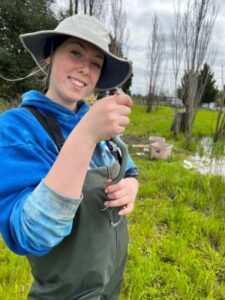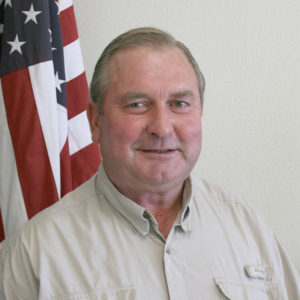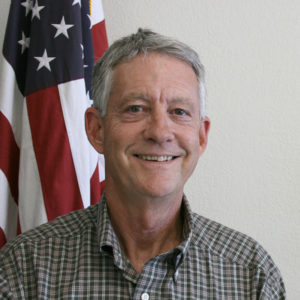Glossary & Acronyms
Glossary
100-Year Flood. That flood event that has a one-percent chance of occurrence in any one year.
Acceptable Outlet. That point where storm water run-off can be released into a watercourse or drainage way of adequate capacity without causing scour or erosion.
Alluvial Fan. A sloping, fan shaped mass of sediment deposited by a stream where it emerges from a nupland onto a plain.
Alluvium. A general term for all detrital material deposited on or in transit by streams, including gravel, silt, clay, and all variations and mixtures of these. Unless otherwise noted, alluvium is unconsolidated.
Angle of Repose. The angle beyween the horizontal and the maximum slope that a soil assumes through natural processes.
Apron. A floor or lining to protect a surface from erosion. For example, the pavement below chutes, spillways, or the toes of dams.
Aquifer. A natural underground formation that is saturated with water, and from which water can be withdrawn.
Attainment Area. An area determined to have met federal or State air quality standards, as defined in the federal Clean Air Act or the California Clean Air Act. An area may be an attainment area for one pollutant and a non-attainment area for others.
Easement. A right given by the owner of land to another party for specific limited use of that land. An easement may be acquired by a government through dedication when the purchase of an entire interest in the property may be too expensive or unnecessary.
Environmental Impact Report (EIR). A document used to evaluate the potential environmental impacts of a project, evaluate reasonable alternatives to the project, and identify mitigation measures necessary to minimize the impacts. The California Environmental Quality Act (CEQA) requires that the agency with primary responsibility over the approval of a project (the lead agency) evaluate the project’s potential impacts in an Environmental Impact Report (EIR).
Endangered Species, California. A native species or sub-species of a bird, mammal, fish, amphibian, reptile, or plant, which is in serious danger of becoming extinct throughout all or a significant portion of its range, due to one or more factors, including loss in habitat, change in habitat, over-exploitation, predation, competition, or disease. The status is determined by the State Department of Fish and Game together with the State Fish and Game Commission.
Endangered Species, Federal. A species which is in danger of extinction throughout all or a significant portion of its range, other than the species of the Class Insect determined to constitute a pest whose protection under the provisions of the 1973 Endangered Species Act, as amended, would present an overwhelming and overriding risk to humans. The status is determined by the US Fish and Wildlife Service and the Department of the Interior.
Environmental Setting. The physical conditions in an area, including land, air, water, minerals, flora, fauna, ambient noise, and objects of historical or aesthetic significance, which will be affected by a proposed project. The area involved shall be the area in which significant effects would occur either directly or indirectly as a result of the project. The “environment” includes both natural and man-made conditions.
Erosion. The process by which material is removed from the earth’s surface (including weathering, dissolution, abrasion, and transportation), most commonly by wind or water
Fault. A fracture in the earth’s crust forming a boundary between rock masses that have shifted. An active fault is a fault that has moved recently and which is likely to again. An inactive fault is a fault which shows no evidence of movement in recent geologic time and little potential for movement.
Groundwater. Water under the earth’s surface, often confined to aquifers capable of supplying wells and springs.
Groundwater Recharge. The natural process of infiltration and percolation of rainwater from land areas or streams through permeable soils into water-holding rocks that provide underground storage (i.e. aquifers).
Habitat. The natural environment of a plant or animal.
Hazardous Material. A material or form of energy that could cause injury or illness to persons, livestock, or the natural environment.
Hazardous Waste. Waste which requires special handling to avoid illness or injury to persons or damage to property. Includes, but is not limited to, inorganic mineral acids of sulfur, fluorine, chlorine, nitrogen, chromium, phosphorous, selenium and arsenic and their common salts; lead, nickel, and mercury and their inorganic salts or metallo-organic derivatives; coal, tar acids such as phenol and cresols and their salts; and all radioactive materials.
Hydrocarbons (HC). Gases emitted from incomplete combustion of gasoline and from evaporation of petroleum fuels, representing unburned and wasted fuel.
Impervious Surface. Any material which reduces or prevents absorption of water into land.
Infiltration. The introduction of underground water, such as groundwater, into wastewater collection systems. Infiltration results in increased wastewater flow levels.
Infrastructure. Permanent utility installations, including roads, water supply lines, sewage collection pipes, and power and communications lines.
LAFCO. Local Agency Formation Commission.
Less than Significant Impact. An impact that would not result in a substantial and adverse change in the environment and would not require mitigation.
Liquefaction. A sudden large decrease in the shearing resistance of a cohesionless soil, caused by a collapse of the structure by shock or strain, and associated with a sudden but temporary increase of the pore fluid pressure.
Littoral Drift. The sedimentary material moved in the littoral zone under the influence of waves and current.
Major Land Resource Areas (MLRA). Consists of geographically associated land resource units (see below)
Major Land Resource Units. Geographic areas of land, usually several thousand acres in extent, that are characterized by particular patters of soil (including solpe and erosion), climate, water, resources, land use and type of farming.
Mitigation Measure. Action taken to reduce or eliminate environmental impacts. Mitigation measures are required as a component of an environmental impact report (EIR) if significant impacts are identified.
Mulch. Covering on surface of soil to protect and enhance certain charcteristics, such as water retention qualities.
Native (Grasses). Occuring naturally, not introduced from other countries.
Outfall. The point where water flows from a conduit, stream or drain.
Ozone. A compound consisting of three oxygen atoms, that is the primary constituent of smog. It is formed through chemical reactions in the atmosphere involving volatile organic compounds, nitrogen oxides, and sunlight. Ozone can initiate damage to the lungs as well as damage to trees, crops, and materials. There is a natural layer of ozone in the upper atmosphere, which shields the earth from harmful ultraviolet radiation.
Point Source. A source of pollutants which may be traced to a discrete point of emission.
Rare Species. A condition in which a species or subspecies, although not currently threatened with extinction, exists in such small numbers throughout its range that it may be endangered if the quality of its environment worsens.
Retention Area. A pond, pool, lagoon, or basin used for the storage of water runoff.
Richter Scale. A logarithmic scale developed in 1935/36 by Dr. Charles F. Richter and Dr. Beno Gutenberg to measure earthquake magnitude by the amount of energy released, as opposed to earthquake intensity as determined by local effects on people, structures, and earth materials.
Riparian. Pertaining to the bank of a natural course of water, whether seasonal or annual. Riparian habitat is defined by the surrounding vegetation or presence of known wildlife movement pathways; it borders or surrounds a waterway.
Sedimentation. Process by which material suspended in water is deposited in a body of water.
Significant Impact. CEQA (§ 21068) defines a significant impact as that which has “a substantial, or potentially substantial, adverse change in the environment.” Mitigation measures are proposed, where feasible, to reduce the magnitude of significant impacts.
Significant and Unavoidable Impact. An impact that would result in a substantial adverse effect on the environment which would not be mitigable to a less-than-significant level. A project with such an impact could still proceed, provided the City prepare a Statement of Overriding Considerations, pursuant to Section 15093 of the CEQA Guidelines, explaining why the City would proceed with the project despite the occurrence of such an impact. Siltation. The process of silt deposition. Silt is a loose sedimentary material composed of finely divided particles of soil or rock, often carried in cloudy suspension in water.
Solid Waste. Unwanted or discarded material, including garbage, with insufficient liquid content to be free flowing.
Sphere of Influence (SOI). The ultimate service area of a city or incorporated area as established by LAFCO.
Threatened Species, California. A species of animal or plant is endangered when its survival and reproduction in the wild are in immediate jeopardy form one or more causes, including loss of habitat, change in habitat, over-exploitation, predation, competition, disease, or other factors: or when although not presently threatened with extinction, the species is existing in such small numbers that it may become endangered if its environment worsens. A species of animal or plant shall be presumed to be rare or endangered as it is listed in: Sections 670.2 or 670.5, Title 14, California Code of Regulations; or Title 50, Code of Federal Regulations Sections 17.11 or 17.12 pursuant to the Federal Endangered Species Act as rare, threatened, or endangered.
Threatened Species, Federal. A species which is likely to become an endangered species within the foreseeable future throughout all or a significant portion of its range.
Threshold of Significance. The established and identifiable quantitative, qualitative, or performance levels of environmental effect beyond which environmental impacts are considered to be significant. Thresholds of significance are based on current City policy and other normally accepted standards for environmental review.
Urban Growth Boundary (UGB). The line within which all urban development is to be contained.
Viewshed. The geographic area visible from a fixed point.
Volatile Organic Compounds (VOCs). A group of chemicals that react in the atmosphere with nitrogen oxides in the presence of heat and sunlight to form ozone: does not include methane and other compounds determined by EPA to have negligible photochemical reactivity. Examples of VOCs include gasoline fumes and oil-based paints.
Wetlands. An area at least periodically wet or flooded; where the water table stands at or above the land surface (bogs and marshes). Also those areas that are inundated or saturated by surface or groundwater at a frequency and duration sufficient to support, and that under normal circumstances do support, a prevalence of vegetation typically adapted for life in saturated soil conditions. Wetlands generally include swamps, marshes, bogs, and similar areas.
Wildlife Corridors. A natural corridor, such as an undeveloped ravine, that is frequently used by wildlife to travel from one area to another.
Williamson Act. Known formerly as the California Land Conservation Act of 1965, it was designed as an incentive to retain prime agricultural land and open space in agricultural use, thereby slowing its conversion to urban and suburban development. The program entails a ten-year contract between the City or County and an owner of land, whereby the land is taxed on the basis of its agricultural use rather than its market value. The land becomes subject to certain enforceable restrictions, and certain conditions must be met prior to approval of an agreement.
Acronyms
AC: Advisory Committee
ACOE: United States Army Corps of Engineers (Corps): usace.army.mil
ACP: Agricultural Conservation Program
ARS: Agricultural Research Service: ars.usda.gov
ASCS: Agricultural Stabilization and Conservation Service
ARMC: Sonoma Marin Animal Resource Management Committee
BAASD: Bay Area Alliance for Sustainable Development: bayareaalliance.org
BASMAA: Bay Area Stormwater Management Agencies Association: basmaa.org
BCDC: San Francisco Bay Conservation and Development Commission: bcdc.ca.gov
BMPs: Best Management Practices
CAC: California Agriculture Census: nass.usda.gov/Statistics_by_State/California
CALFED: CALFED Bay-Delta Program: calwater.ca.gov
CALFIRE: California Department of Forestry and Fire Protection: fire.ca.gov
CALFlora: California plants for conservation, research, and education: calflora.org
CALTrout: California Trout, Inc: caltrout.org
CalSIP: California Land Science Information Project: ceres.ca.gov/calsip/index.html
CalWEED: California Noxious Weed Control Projects Inventory: ice.ucdavis.edu/weeds/default
CBARCD: Council of Bay Area Resource Conservation Districts
CCC: California Coastal Conservancy: coastalconservancy.ca.gov
CDEC: California Data Exchange Center – California Department of Water Resources: cdec.water.ca.gov
CDF: California Department of Forestry: cdf.ca.gov
CDFW: California Department of Fish and Wildlife: wildlife.ca.gov
CEQA: California Environmental Quality Act: resources.ca.gov/ceqa
CERPI: California Ecological Restoration Projects Inventory: ice.ucdavis.edu/project/nrpi
CIWMB: California Integrated Waste Management Board: ciwmb.ca.gov
COOC: California Olive Oil Council: cooc.com
COMTF: California Oak Mortality Task Force: suddenoakdeath.org
CRA: California Resources Agency: resources.ca.gov
CRMPs: Coordinated Resource Management Plans
CWPI: California Watershed Project Inventory
DFW: California Department of Fish and Wildlife
DOC: California State Department of Conservation: consrv.ca.gov
DWR: Division of Water Rights, State Water Resources Control Board
EIR: Environmental Impact Report (CEQA)
EIS: Environmental Impact Statement (NEPA)
EPA: United States Environmental Protection Agency
EPA-WATERS: Environmental Protection Agency’s Watershed Assessment, Tracking and Environmental Results: epa.gov/waters
EQIP: Environmental Quality Incentives Program
FFA: Future Farmers of America
FRAP: Fire and Resource Assessment Program: frap.fire.ca.gov
FSA: Farm Services Agency (USDA): fsa.usda.gov
FWS: Fish and Wildlife Service – United States Department of the Interior fws.gov
GIS: Geographic Information Systems: esri.com/what-is-gis
GRRCD: Gold Ridge Resource Conservation District: goldridgercd.org
ICE: Information Center for the Environment: ice.ucdavis.edu
IHRMP: Univ. of Calif. Integrated Hardwood Range Management Program: View & Download PDF
IPM: Integrated Pest Management
LAFCO: Local Agency Formation Commission of Sonoma County: sonomalafco.org
LAO: Legislative Analyst’s Office – The LAO provides nonpartisan fiscal and policy analysis to the California Legislature: lao.ca.gov
LUPIN: California Land Use Planning Information Network: ucanr.edu/sites/ANR_LUWG/Government_Resources
MCRCD: Mendocino County Resource Conservation District: mcrcd.org
MRCD: Marin Resource Conservation District: marinrcd.org
NACD: The National Association of Conservation Districts: nacdnet.org
NASDA: National Association of State Departments of Agriculture: nasda.org
NCRCD: Napa County Resource Conservation District: naparcd.org
NEPA: National Environmental Policy Act: epa.gov/nepa/what-national-environmental-policy-act
NOAA: National Oceanic and Atmosphere Administration: noaa.gov
NPS: Non-point Source Pollution: epa.gov/owow/nps
NPS: National Park Service: nps.gov
NRCS: National Resources Conservation Service (USDA): ca.nrcs.usda.gov
NRPI: Natural Resource Project Inventory: ice.ucdavis.edu/nrpi/home
OHWM: Ordinary High Water Mark
OPR: Office of Planning and Research (California State Clearinghouse)
PCI: Prunuske Chatham, Inc.: pcz.com
PWF: Petaluma Watershed Foundation
RCD: Resource Conservation District
RDM: Residual Dry Matter, expressed in pounds per acre, left in a field after being grazed
RWQCB: Regional Water Quality Control Board: swrcb.ca.gov
SCAC: Sonoma County Agricultural Commissioner: sonoma-county.org/agcomm
SCC: California State Coastal Conservancy: coastalconservancy.ca.gov
SCPRMD: Sonoma County Permit and Resource Management Department: sonoma-county.org/prmd
SCWA: Sonoma County Water Agency: scwa.ca.gov
SFBJV:The San Francisco Bay Joint Venture: sfbayjv.org
SFBCDC: San Francisco Bay Conservation and Development Commission: bcdc.ca.gov
SFEI: San Francisco Estuary Institute: sfei.org
SFSCC: State Forest Stewardship Coordinating Committee (California Forest Stewardship Program): calfire.ca.gov/foreststeward/committee
SMRC: Stormwater Manager’s Resource Center, Center for Watershed Protection, Inc: stormwatercenter.net
SOD: Sudden Oak Death – Monitoring in California: suddenoakdeath.org
SOI: Sphere of Influence
SWRCB: State Water Resources Control Board: swrcb.ca.gov
TESS: Threatened and Endangered Species System – US Fish and Wildlife Service: fws.gov/endangered
TMDL: Total Maximum Daily Load
UFEI: Urban Forest Ecosystems Institute: ufei.calpoly.edu
UC: University of California
UCCE: University of California Cooperative Extension: ucanr.edu
UGB: Urban Growth Boundary
USDA: United States Department of Agriculture: usda.gov
USGS: United States Geological Survey
USLE: Universal Soil Loss Equation
VOCs: Volatile Organic Compounds
WHDAB: Wildlife and Habitat Data Analysis Branch: wildlife.ca.gov/Explore/Organization/BDB




































